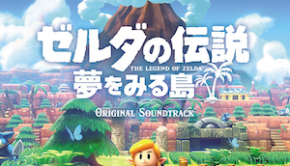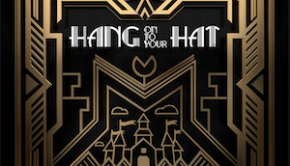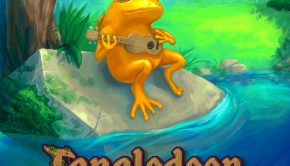Super Mario 64: Portrait of a Plumber
 |
Album Title: Super Mario 64: Portrait of a Plumber |
| Record Label: OverClocked ReMix |
|
| Catalog No.: OCRA-0048 |
|
| Release Date: June 16, 2014 |
|
| Purchase: Download at OverClocked ReMix |
Overview
Super Mario 64 marked a distinct change in video games when it first debuted for the Nintendo 64 in 1996, transitioning from flat linear levels, to a fully rendered three-dimensional world that players could explore and play to their hearts content. With this change in space and play-style also came a change in composer Koji Kondo’s music. Although the traditional upbeat and peppy Mario music is preserved in such tracks as “Super Mario 64 Theme,” and the infamous “Slider” theme, a lot of Super Mario 64’s music centers around matching the location, rather than matching the player’s tempo, and leads to several ambiance-like tracks (Koji Kondo would continue to use this mentality in several other games). In either case, Super Mario 64 features a memorable soundtrack that is still very much relevant in gamer’s eyes. Nowhere is this more apparent than in OverClocked ReMix’s Super Mario 64: Portrait of a Plumber, which features a wide variety of musical styles across its hour and a half running time, and covers nearly every aspect of the original’s music.
Body
The “typical” Mario sound is captured perfectly early on in Portrait of a Plumber with “Somebody Set Up Us the Bob-omb,” a remix of the main theme headed up by Theory of N. It sticks very closely to the original, bringing a funky chiptune styling to the melody, while changing parts of the theme around to bring a fresh, fun sound that should appeal to retro and new fans of the game. “Roads to Everywhere” on the other hand, is a laid back remix of the short “File Select” theme from the original. Remixer Argle brings an acoustic rhythm guitar and a very characteristically-Mario sounding Latin percussion into the mix, while often changing with some electronic progressions, resulting in a very relaxing, but still upbeat listen. “Hush Hour,” by Sir Jordanius and G-Mixer, is, in contrast, a very electric experience, starting with a live recorded street-ambiance, before launching into a fast-paced jazzy rendition of the “Slider” theme, going through several instrumentations and samples, while never letting up its rhythmic melody. It’s essentially “Slider” meets a big city Jazz sound, and is definitely a delightful highlight to the album.
Rounding out some of the more upbeat tracks on the album, we have “Mari-O-Round,” from The Coop, a nice sounding remix of the very short “Merry-Go-Round” motif, which sounds straight off of a theme park parlor. “Peach’s House Party,” another mix from Sir Jordanius, tackles on the hub-world theme, “Inside the Castle Walls,” and does a good job of retaining the original’s vibrant attitude, while throwing the whole mix off for a loop every now and then in fun and appropriate ways, despite using vocal samples and sound effects in rather obtrusive ways. “Dire, Dire Docks,” has always been a beloved theme from Mario 64, having a soothing melody with an upbeat drum layer added in as Mario progressed through the level. Fishy absolutely nails this mix, conserving the original’s atmosphere while converting the song into an electric guitar ballad. It’s easily one of the best remixes on the album. “The Third Dimension” by halc is also equally as good, despite it being a rather well-worn song. “Title Screen” was originally a drum and bass remix of the Super Mario main theme. Here, halc decides not to mess with it too much, and gives everything a chiptune makeover. Despite the rather simplistic approach to this classic song, it is still a very enjoyable listen.
The remixers also attempt to capture some of the more ambiance-driven tracks, to sometimes mixed results. “Through the Flames,” by project lead Nutritious, is an interesting take on “Lethal Lava Land,” focusing on giving the sparse composition a more melody-driven, orchestral sound. The end result hardly resembles the original, and yet creates a nice classical atmosphere that’s on par with the original’s more progressive, Indian feel. Fratto covers the “Haunted House” theme next with “Boo’s Cues,” layering the track with atmospheric effects like thunder, rain, footsteps, Boo’s laugh, and Mario’s panting. It works rather well at first, but Fratto ends up adding in some bombastic orchestrations which sound less like “Haunted House’s” eerie and surprisingly scary droning melody, and more like Super Mario World’s “Ghost House,” giving it a rather cheesy and typical sound. “Cave Dungeon” is perhaps the most Mario-sounding of the original’s ambiance driven tracks, taking the original “Underground” theme from Super Mario Bros. and adding percussion and an expansive choral sound, giving it an ancient and exploring touch. Here, the track is remixed twice by Sole Signal, with “Find the Red Coin” and “Grab the Blue Coin!” The former adds an electric and bass mix, and keeps the original’s tempo intact, while the latter takes “Cave Dungeon” in an upbeat dance-like direction. While not the most memorable tracks, they do a god job exploring this side of Mario 64’s sound direction and complement each other well.
There are a few tracks here that also stray away from the norm, with equally mixed results here and there. For instance, the opening track, “The Strange Green Pipe,” by Mikeaudio, a digital sounding medley through several of the game’s themes, does a good enough job giving a nostalgic feeling and sets up the album rather nicely, but at times it’s just a bit too industrial and all over the place thematically to make it truly memorable. “Supersnowman,” a remix of the upbeat and fun “Snow Mountain,” has a very Holiday-like pizzicato backing added to it, but Electric Concerto’s instrumentation choices just sound very grating and repetitive after a while. “junkie” another take of the “Mario 64 Theme,” is an acapella song by prophetic, literally about how addicting and repetitive the main theme is. It’s meant as a joke song, and to that extent it works, but it also feels jarringly out of place here. There are also two power up themes remixed on this album, “Wings to the Sky” by halc and “Prog Mario,” by Brandon Strader. Both are rather repetitive, but“Wings to the Sky,” works a bit better as a rather simple remix that uses Mario sound effects in an entertaining manner, while Prog Mario,” on the other hand is an extended heavy jam session that wears its welcome fairly quickly.
Speaking of heavy jam sessions, the album also covers some of the climactic boss themes in Mario 64. “Devastation’s Duel,” by Sole Signal and Fishy, is a cover of the main boss battle theme between Bowser and Mario, and works as a rock-infused electronic track, with some orchestral synths thrown into the mix. It also mixes some of the other Bowser related themes in as well and is extremely reminiscent of the guitar work in the Bowser Castle themes present in Mario Kart, making for a great tribute to Mario’s main baddie. “Perilous Pathway,” Nutritious’ second outing on the album takes the orchestral melody of “Koopa’s Road” and remixes it with dubstep thrown everywhere. Though climactic, it really doesn’t do anything too special, besides speeding up the tempo halfway through the song and adding a rhythm guitar section. Scardism tackles on the final boss theme, “So Long-eh, Bowser!,” a piano driven song, with backing drums and string synths. The original song was a departure from the rest of the soundtrack, and here it’s no different. Using the piano gives the song a more tragic feeling all the way through, and is an interesting take overall.
Sole Signal returns yet again to close out the album with “See You Next Time,” a remix of Mario 64’s end credits. The remix is another very laidback affair, never straying too far from the original’s nostalgic melody, despite sometimes being a bit more dramatic sounding than the original. Despite this serves as a great ending to this album. However, like the original the soundtrack truly closes out with “Piranha Plant’s Lullaby,” remixed by Tuberz McGee as “Do Piranha Plants Dream of Electric Italians?” The remix is also on the simple side, despite Tuberz apparently learning the song backwards and playing it back forwards to give it a dreamy feeling. The song is a great final remix, using music boxes, accordions and guitars effectively.
Summary
Super Mario 64: Portrait of a Plumber succeeds overall as a great tribute to a classic game. Though not every remix is up to par, and some tend to do some obnoxious things with their songs, OCRemix has delivered another great album to their ever growing library, and is likely to bring old and new fans back to the world of Super Mario 64.
Do you agree with the review and score? Let us know in the comments below!
3.5
Posted on March 22, 2015 by Julius Acero. Last modified on March 22, 2015.














